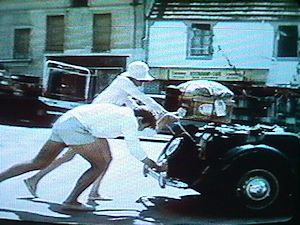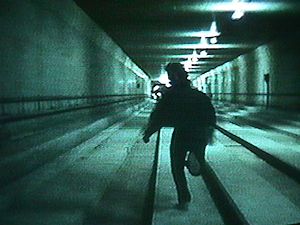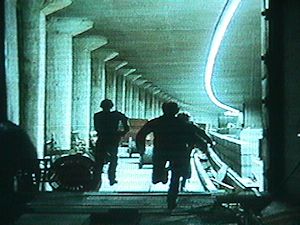2000.11.11
more vehicles than roads?
In M's last post on Two for the Road he wrote, "Most of Wim Wenders' works are 'road films' as well." The only Wenders film I've seen is Wings of Desire, so I'll briefly get back to that film after I make a distinction between 'road films' and films, like Two for the Road and Spetters, where vehicles are more potent message delivers than are the roads the vehicles travel on.
In Two for the Road we see Mark and Joanna crisscrossing the French countryside in an extensive sequence and array of cars, culminating with the Mercedes coupe. Each car corresponds to a different period of time within Mark and Joanna's relationship, and indeed each (style of) car carries its own symbolic message vis-à-vis the different phases of Mark and Joanna's life together (the station wagon with the proto-yuppie couple/friends and the couple's bratty daughter is classic modern social commentary). Automobiles are not the only vehicles employed in the movie, however. For example, the movie opens with the Mercedes being driven into the back of an aircraft, and it is another (privately owned) airplane that transports Joanna to her one marital infidelity. Plus there is the great scene where the young and still unmarried Mark and Joanna wake up with utter surprise to find themselves 'touring' the French countryside from within a huge concrete sewer pipe truckin' its way to some construction site (and keep an eye out for that bulldozer on the 'developing' beach).
 
Verhoeven's Spetters (which I first saw in 1984 and again on tape in 1986) is about three Dutch teenage boys that are somewhat local sports hero's from the town's motorcycle racing team. This movie is a nimiety (i.e., an abundance of redundance) of all kinds of vehicles. The lad who is the best racer has a
bad motorcycling accident, winds up in a wheelchair (going from two wheels to four wheels), and ultimately commits suicide by rolling himself onto a highway where he is quickly run over by a very fast moving truck. Then there is the 'puritanical' farmer father of one of the boys that chases his son on the edge of a field while he, the father, is driving an enormous tractor. The boy is experiencing his father's wrath because the son has been associating with the local "whore of Babylon." The "whore" lives in and runs a luncheon business out of a camper hitched to the back of her car (which, if memory serves me correctly, is something like a 1970s Chevy Impala). The most popular item on the luncheon menu is extra long hot-dogs. [The actress who plays the "whore" is the same actress who in Verhoeven's The Fourth man performs something just above castration in one of the neurotic dreams of 'the fourth man'.]
What I like about these movies is how vehicles are both very literal and very symbolic, and, moreover, it is the seamless transition from literalness to symbolism that the vehicles deliver.
So, doesn't the title Wings of Desire say it all for itself? Angel wings as the vehicle that might just deliver us to our most lofty desires.
2000.11.13
memories of desire?
I wanted to rent Paris, Texas, but it was out, so I rented Spetters and Ulysses' Gaze.
In watching Spetters (14 years since I last did so) I have to report the mistakes I made in my last post about that film. What's funny is the types of mistakes my memory made.
The boys are all 20 years old, (not teenagers). The farmer father does not chase his son on a tractor, rather pulls the "whore of Babylon's" Chevy Impala (I was right about that) out of a roadside ditch that the farmer's son stupidly backed into. The 'puritanical', farmer father does routinely beat his son, however (and the son has a definite sado-masochistic streak to him -- he gets himself 'coiled up' in the 'sub-plot' within the under-construction subway).
 
Only two of the boys are amateur racers, while the farmer's son is an auto mechanic at the gas station.
And here's my favorite memory mistake: it is not extra long hot-dogs that are the most popular item at the "whore's" luncheon business, rather it is 'croquettes' (or something spelled like that) which, unknown to the customers, are made of canned dog food. [Obviously serving the question, "is real fast food actually any better?"]
Overall, I was correct that Spetters is a nimiety of vehicles. It's like Two for the Road on multiple steroids.
After now being well re-acquainted with both films, what's really interesting is the difference the 1970s made. The change in 'style' from Two for the Road (1967) to Spetters (1980) is very noticeable, and the fact that both films are 'vehicular' heightens the changes. There is one very weird coincidence between the two films, however. The station wagon in Spetters is also driven by a family (husband, wife, a boy and a girl), and the hero of the film has his paralyzing motorcycle accident because the husband in the station wagon throws a bag of orange peels out the car window while he's driving. Perhaps it really isn't odd that the station wagon and the nuclear family come to represent conformity in both films, but they also come to represent the 'death' of the free (wheeling) spirit.
 
Alas, I finished watching Spetters and then began to watch Ulysses' Gaze (which I've never seen before but have the soundtrack of for two years now), and the pace went from 75 MPH to 5 MPH. I haven't finished watching the film yet, but it looks like one might be able to analyze the 'vehicles' in it as well. But it won't surprise me if the notion of "film" itself turns out to be Ulysses' Gaze's primary vehicle.
| |
2000.11.20
Signing of Buildings
I was very busy last week designing my tombstone, and, lucky for me, without this 'signing of buildings' thread here at design-l I would never have thought of applying my signature to the inscription. Now I'm sure to rest more peacefully because everyone will know I designed my own marker.
Stephen Lauf
1956 - ____
He didn't know a thing
but
They said he had a nice signature style
signature ____________________
2000.11.21
emergence from the East
Rick's post about the sack and ultimate fall of Constantinople is indicative of much history that does not often get mentioned in Western culture. I personally first learned about the later history of Constantinople in the early 1990s, particularly about the very significant role that mid-15th century Byzantine scholars played in the advancement of (Italian) Renaissance Classical/Humanist thought. The Byzantine scholars were fleeing the advancing Ottomans, and brought to Italy many ancient/classical texts that the West knew of by name but otherwise thought to be no longer in existence. It is fair to speculate that the Renaissance as we now know it would never have 'emerged' without the scholarship of the Eastern Roman
Empire.
What Rick did not mention is that the 1204 'western' sack of Constantinople also started the Catholic Church schism that is still official to this very day. Indeed, there are TWO Holy Apostolic Churches (and if you asked me it's totally up to the Roman Catholic Pope to end the schism by admitting Roman/Latin wrong-doings and even make restitutions). But it can also be reasoned that Constintine himself started the Christian split between East and West when he made Constantinople his official Roman Imperial capital in 330 AD.
At the time of Constantine's Christian 'conversion' at the Milvian Bridge in Rome on the eve of 28 October 312, Christianity was already a well established (albeit occassionally persecuted) organization with a diocesan hierarchy of bishops firmly in place and the bishop of Rome the Church leader. Althought Rome was symbolically the supreme city of the Empire, the four Imperial capitals at that time were Nicomedia (today's Izmit, Turkey), originally the capital/court of Diocletian (and subsequent Eastern Augusti) where Constantine actually spent his formative years; Milan, seat of the Western Augustus, Thessalonica, seat of the Eastern Caesar (ie, junior Augustus), and Treves (Trier, Germany), seat of the Western Caesar. Jerusalem was then a Roman city built by Hadrian, with a Temple of Venus on the site of the Holy Sepulcher (of Christ).
Trier was Constantine's capital/official residence from 306 to c. 314 -- Constantine moved around a great deal throughout the Empire during his entire reign, mostly on military expeditions. Constantine's throne hall, the Aula Palatina, at Trier is perhaps the best example of the Roman basilican type to be built immediately prior to the construction of the Christian basilicas in Rome. Interestingly, we learn from Ward-Perkins (Roman Architecture) that the brickwork of the Aula Palatina is the first instance
of such work in the West, with earlier example of such work in the East, indicating that Constantine may well have imported the best artisans from places in the East, like Nicomedia, which is where he lived before residing at Trier. Helena most likely met Eutropia at Trier, since it was at Trier that Constantine married Fausta, Eutropia's daughter. The ruins of the Constantinian Imperial baths at Trier were the largest Imperial baths outside of Rome, and their construction is very similar to the construction of Helena's mausoleum in Rome.
At the same time that Constantine was ruling the northeastern part of the Empire from Trier, Maxentius was usuptively ruling Italy and Northern Africa from Rome. Maxentius was the son of Eutropia, and the brother of Fausta. Maxentius also built some very large Roman buildings while in power, eg, a gigantic circus along the Appian Way, and actually began the construction of what is today called the Basilica of Constantine in the Roman Forum (not to be confused with the Christian basilicas).
[I now wonder whether the artisans that built the Aula Palatina in Trier where also the artisans that built the first Christian basilicas in Rome just after 312 AD. Or, more probably, did the eastern artisans finally meet the artisans of Rome, thus generating a new style?]
The spiral columns of Bernini's baldachine in St. Peter's are based on a set of columns that formed a screen around the altar of the original St. Peter's Basilica. Legend says that the columns came from Solomon's Temple, but all we really know is that columns where brought to Rome from Greece. It was during Constantine's reign that the particularly offensive Pagan religions were outlawed and their temples dismantled and their treasuries confiscated. It is well known that the columns in early Christian basilicas were from preexisting buildings/temples. I like to think that the original spiral columns of St. Peter's were actually the most beautiful columns in the Roman empire at that time, and that they were personally procured by Helena, who made sure they wound up at St. Peter's. (It is historically recorded that while Constantine was sole ruler of the Empire (ie, after 19 September 324) he granted Helena access to the Empire's treasury that was equal to Constantine's own access, ie, she could do and spend in any way she saw fit.) The columns still exist today, and a pair of them is in each of the upper niches of the four piers holding up the dome of St. Peter's.
So it seems that the Vatican has 'received' it's richest treasures from the East from the very beginning.
ps Constantine founded Constantinople 8 November 324 [curiously close to 9 November] and Constantinople was officially dedicated 11 May 330.
| |
2000.12.01
context (Quondam thinking?)
Whenever I read about architecture and context I can't help but automatically recall my architectural education at Temple University, Philadelphia, 1975-81. Temple's architecture program was then in its infancy (begun 1973), and the faculty were largely either/and/or students of Louis Kahn, former employees of Louis Kahn, current or former employees of Romaldo Giurgola (Mitchell/Giurgola Architects), or employees at Venturi and Rauch Architects. Besides that 'august' lineage, what impressed my design thinking most was the issue of designing with respect to context, indeed I'd say that that notion was the touchstone of my entire formal architectural education. [I also have a strong independent streak when it comes to continually self educating myself architecturally, and my subscribing to Oppositions throughout the late 1970s through the early 1980s--I have all 26 issues except nos. 1 and 3--is just one example of that. Oppositions was never required reading at Temple U. while I was there.]
I now want to make a bold statement regarding (the evolution of?) contextualism and architecture:
What is probably the best example of Philadelphia architecture from the 1990s happens to not be in Philadelphia at all, rather it is in London, namely the Sainsbury Wing addition to the National Gallery by Venturi, Scott Brown and Associates, Philadelphia.
I have never been to London, but I know the Sainsbury Wing fairly well via publications, plus, and here's the beginning of my point, I almost viscerally understand all the 'contextual' design idioms and eccentricities because they are, and the building as a 'whole' is, a consummate example of (questionably labeled post-modern) Philadelphian contextual architectural design thinking. I'm not suggesting that Philadelphia has some sort of propriety when it come to designing architecture contextually in the late 20th century, rather that there is a uniqueness to Philadelphia's 'brand' of contexturalism (indeed retrospectively related to Rowe's thinking, but clearly distinct nonetheless mostly because of Giurgola and Venturi who both taught at the University of Pennsylvania at the same time that Kahn taught there). What's wonderful about the Sainsbury Wing is that as a program and site it boiled down to being almost entirely about designing in context, and, with Venturi and Scott Brown as the competition winners, they were given the opportunity to do, in a sense, a 'hyper' contextual building, i.e. dealing with both London (and even royal) contexts as well as Philadelphia's theoretical architectural 'contexts'.
I'm going to be even more bold by suggesting that the Sainsbury Wing is not so much 'post-modern' design, rather very good 'post-imperial' design. Isn't the UK still more specifically operating within a post-imperial milieu (as a childhood stamp collector of the 1960s I'm very aware of exactly how and when the British Empire ended) and isn't Philadelphia the foremost post-imperial city when it comes to the British Empire--site of the Declaration of Independence and all that? I actually think the world of architecture is extremely fortunate to have an iconic post-imperial building in a post-imperial capital transplanted there by architects from the Empire's proto post-imperial city.
[Earlier, when the discussions here centered on evolution versus invention of style, I wanted to introduce the notion of Venturi's role vis-à-vis POMO, specifically the publication of Complexity and Contradiction in Architecture, which is based almost entirely on the early 1960s architectural theory course that Venturi taught at the University of Pennsylvania (in Philadelphia, founded by Benjamin Franklin). Essentially, I wanted to raise the question as to what influence the Philadelphia 'context' had on 'Post-Modern Architecture'. If you asked me, I'd say the influence was indeed seminal, and Venturi's Mother's House (Chestnut Hill, Philadelphia, a 15 minute ride from where I'm presently sitting as I write this) had a great deal to do with the earliest manifestation (dare I say invention?) of what has come to be labeled Post Modern Architecture.]
I'm going to table the issue of what exactly Philadelphia contextualism is in specific terms of style, and instead ask all you that can readily visit the Sainsbury Wing to go there next time with the thought that you are going to a truly Philadelphian building because the style you'll see there is, like I said, an example of Philadelphia architecture at its best. If you don't know Philadelphia itself, and/or are not too familiar with Philadelphia's indigenous architecture, I'd suggest concurrently looking at (any book on) the architecture of Frank Furness (1839-1912), the sort of ur-architect of Philadelphia uniqueness and perhaps Venturi's strongest stylistic influence.
Like Venturi and (almost) Kahn, I am a Philadelphia native (although I'm also the only member of my immediate family born in America), and I've sort of made Philadelphia context an integral part of my life, e.g., I've been living in the same Philadelphia house for almost 43 years, all but the first 20 months of my life). As much as Philadelphia is often called the cradle of democracy, a kind of New World Athens, at base (i.e., literally infrastructurally) Philadelphia is a Roman colonial camp reenactment (and you might even put camp in quotes, a la Learning from Las Vegas via Philadelphians). Philadelphia's original plan is a Roman grid complete with a real cardo and a real decumanus, and the plan is still very much intact today. Indeed, Broad Street, the north-south axis is the longest straight street (in an urban context) in the world, an ultimate cardo, primary axis if there ever is one (and Stauffer Hall, the site of Temple University's architecture program from 1973-1980 was right on Broad Street). I don't have to tell all of you how much I look to/at Rome, but I should mention that the main reason I started redrawing and studying Piranesi's Campo Marzio (and all the subsequent ancient Roman studying being done like on St. Helena) is because I was inspired by the fact that Louis I. Kahn, throughout his mature years, had a copy of Piranesi's Campo Marzio plan hanging on the wall over his desk at his office (on Walnut St. in downtown Philadelphia, and no I'm not suggesting that Kahn was some kind of 'wall nut'). After Learning from Las Vegas, Venturi next published a group of essays under the title A View from the Campidoglio, and just a few years ago it dawned on me that when one is actually standing at the Campidoglio in Rome, the view being taken in is literally Rome's Campo Marzio. I'm going to make one final bold statement here, and that is to ask you to now trust me when I say that I continue to see what some of Philadelphia's best architects looked at.
| |
2000.12.02
aesthetics? (etc.)
Picking up on Paul's comments on Frank Furness and whether he is contextual, I'd first off say yes Furness is very contextual, but not exactly in the same way contextualism is generally thought of today. Furness architecture is (unfortunately?) one of those architectures that really has to be experienced in person, pictures just don't suffice. Anyway, the buildings are often very clear albeit uncanny responses to the surroundings; the buildings also often indeed make the 'place'; but, more than anything, it within the compositions of Furness buildings themselves where the contextual dialogue fully occurs--there are virtually always incredible juxtapositions of interior spatial scale, then also tremendous exaggerations of scale among individual elements. None of this is arbitrary because the various scales always reflect various aspects of program and function, and even structure. Aesthetically, the architecture of Furness is all hybrid, or, as Venturi would say, "a difficult whole."
On Kahn, I have to (respectfully) change some of what Paul said, for example that "Kahn has always been more object-oriented, in a traditional architectural sense (and Kahn was indeed a traditionalist)." Kahn for sure had a 'traditional' training, pure Beaux-Arts via Paul Cret, but, as Kahn matured, the orientation was not on 'object'(ness), rather that of conceptually forming the building program as a much higher priority than figuratively forming the building. This at least is what I learned from those of my teachers that studied with and/or worked for Kahn. The figural forms of Kahn's compositions always changed radically during the design process, and this (evolution?) occurred, and is indeed reflective of, the serious ongoing pondering of just what the program of the building "wanted to be." Kahn very much took program to a somewhat spiritual level, and, lucky for him, he found a way for bold and complex geometrical compositions to manifest the conceptualized resultant spirits. For Kahn, context did not so much involve physicality, rather the spiritual realm, specifically that spirit that good architecture should embody, thus making good 'place'. That's why Kahn could simple say, "Order is."
Soon after I graduated from Temple U., I participated in an alumni exhibit hosted by Temple's architecture program, and, among other things, I hung up a sign that said "Order is. . .OK." Most 'Philadelphia's' that saw the sign got what I did immediately; a few appropriately laughed, while most smirked and got stern in the face. Of course, I was commenting on (and hybriding?) Kahn's "Order is." together with Venturi's "Main Street is almost all right." Anyway, Rick makes some interesting comments on Venturi's Complexity and Contradiction in Architecture, e.g., "It was surprising to me to see how thoroughly Contextual (in the philosophical sense of Peirce's Pragmatism) that this work was. Surely, it is the first apology with an Architecturally Contextual base? Not that it was perfectly so, for as I recall, there are a few cases, such as the Jasper Johns Flag on Flag illustration, which a better fit for popular notions of taste, not for thoroughgoing Contextualism." Between 1974 (my senior year in High School) and 1984 I've read Complexity and Contradiction five time, four times reading the chapter in consecutive order, and once reading the chapters in reverse order (and one of the readings was done while on an Italian study tour, which is the best "context" to read that book in). [The only other book I've read multiple times including once in reverse is Revelations, the last book of the New Testament. What I found through that experience is that Revelations actually starts making sense when you read the chapters in reverse "order".] I'll touch upon Rick's insightful focus on Jasper Johns Flag on Flag illustration because it represents Venturi's relationship with POP Art taking precedence over Venturi's relationship with popular culture. The whole aesthetic notion of POP Art flatness (as best described in Tom Wolff's The Painted Word) is an aesthetic that Venturi still to this day strives ardently toward in many aspects of his designs. This 'style' is rarely, if ever, discussed within the plethora of writing on or by Venturi, yet it is definitely a substantial part of Venturi's design psyche. Let me explain further so as not to begin sounding like, as Alex once described, Kenneth (Civilization) Clark when he (Clark) was adamant about what Michelangelo "must have thought." One of my best friends, RE, a former Temple U. classmate, was an associate at Venturi, Scott Brown & Associates for 10 years. Whenever R and I discuss the 'flatness' issue, it gets very intense; R offers lots of actually working examples of the quest for flatness in the design process, and then we inevitably agree that it is somehow amazing that hardly anyone (else) knows about this very integral component of Venturi's style.
|